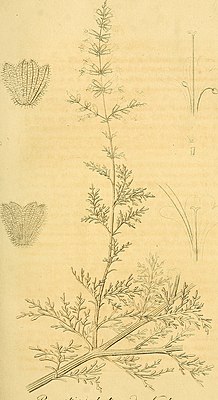Pinnate Perovskia
| Pinnate Perovskia | ||||||||||||
|---|---|---|---|---|---|---|---|---|---|---|---|---|

Pinnate Perovskia ( Perovskia abrotanoides ), illustration |
||||||||||||
| Systematics | ||||||||||||
|
||||||||||||
| Scientific name | ||||||||||||
| Perovskia abrotanoides | ||||||||||||
| Kar. |
The Fiederschnittige Perowskie ( Perovskia abrotanoides ) is a shrub with purple-blue flowers from the family of the mint (Lamiaceae). The natural range is in Asia. The species is often used as an ornamental shrub. According to WCSP, it is better to be incorporated into the genus Salvia than Salvia abrotanoides (Kar.) Sytsma .
description
The pinnately cut perovskia is an approximately 1 meter high, many shoots subshrub with at the base lignified, upright to prostrate-ascending, about 5 millimeters in diameter, gray-white hairy and covered with gold-colored glands. The leaves have a 5 to 8 millimeter long petiole. The leaf blade is 4 to 7 inches long, about 2.5 inches wide, ovate-elongated and pinnate to doubly pinnate. The lobes are elongated to oblong-linear, blunt, 2 to 4 millimeters long and 0.5 to 1.4 millimeters wide, glabrous or sometimes sparsely hairy and densely covered with golden yellow glands.
The flowers grow in groups of four to six in false whorls, which are arranged in loose, 27 to 40 centimeters long panicles. The bracts are 1 to 1.5 millimeters long and about 0.5 millimeters wide, lanceolate-linear, pointed and finely hairy. The flower stalk is about 0.5 millimeters long, hairy and drooping after the flowering period. The calyx is about 4.5 millimeters wide, purple, with white or purple hairs at the base. The calyx tube is 4 millimeters long with a diameter of 1.5 to 2 millimeters. The upper lip of the calyx is short, more or less entire to three times serrated, 1 millimeter long and about 2 millimeters wide. The lower lip is about the same length and has a thickly lashed edge. The corolla is lilac blue, 0.9 to 1.1 inches long and sparsely hairy. The corolla tube is 5 to 6.5 millimeters long and 2 millimeters wide. The upper crown lip is 2.5 to 3 millimeters long and 6.5 to 7 millimeters wide and has egg-shaped to rounded, 1.5 to 2 millimeters long and about 2 millimeters wide lobes. The lower lip is oblong-oval, about 3.5 millimeters long and 2 millimeters wide, with entire margins and blunt.
The nuts are 1.8 to 2 millimeters long and about 1 millimeter wide. The pinnate Perovskia blooms from June to July.
The number of chromosomes is 2n = 20.
Distribution and location requirements
The natural range is in Asia and ranges from Afghanistan and Iran via Tajikistan and Turkmenistan to Pakistan and Tibet . The pinnate Perovskia grows in steppes and dry forests on dry to fresh, weakly acidic to strongly alkaline, sandy, sandy-gravelly or sandy-loamy, nutrient-rich soils in sunny and hot locations. The species is sensitive to moisture and frost. It is assigned to winter hardiness zone 6a with mean annual minimum temperatures of −23.3 to −20.6 ° C.
Systematics
The Fiederschnittige Perowskie ( Perovskia abrotanoides ) is a kind of the genus of Perovskia ( Perovskia ) in the family of Labiatae (Lamiaceae). There it is assigned to the subfamily Nepetoideae of the tribe Mentheae. The species was first scientifically described by Grigorij Silych Karelin in 1841 . The generic name Perovskia is reminiscent of the Russian general and governor of the Orenburg Province Vasily Alexejewitsch Perowski (1794-1857). The specific epithet abrotanoides comes from Latin and refers to the common wood ( Artemisia abrotanum ), which has similar leaves.
A synonym of Perovskia abrotanoides Kar. Is Perovskia artemisioides Boiss.
use
The pinnate Perovskia is often used as an ornamental shrub because of its decorative and fragrant flowers .
proof
literature
- Wu Zheng-yi, Peter H. Raven (Ed.): Flora of China . tape 17 : Verbenaceae through Solanaceae . Science Press / Missouri Botanical Garden Press, Beijing / St. Louis 1994, ISBN 0-915279-24-X , pp. 223 (English).
- Andreas Roloff , Andreas Bärtels: Flora of the woods. Purpose, properties and use. With a winter key from Bernd Schulz. 3rd, corrected edition. Eugen Ulmer, Stuttgart (Hohenheim) 2008, ISBN 978-3-8001-5614-6 , p. 444.
- Jost Fitschen: Woody flora . 12th, revised and expanded edition. Quelle & Meyer, Wiebelsheim 2007, ISBN 3-494-01422-1 , p. 628 .
- Helmut Genaust: Etymological dictionary of botanical plant names. 3rd, completely revised and expanded edition. Nikol, Hamburg 2005, ISBN 3-937872-16-7 (reprint from 1996).
Individual evidence
- ↑ German name after Roloff et al .: Flora der Gehölze , p. 444 and after Fitschen: Gehölzflora , p. 628
- ↑ a b Rafaël Govaerts (Ed.): Perovskia. In: World Checklist of Selected Plant Families (WCSP) - The Board of Trustees of the Royal Botanic Gardens, Kew . Retrieved January 1, 2019.
- ↑ a b Xi-wen Li, Ian C. Hedge: Perovskia abrotanoides in Flora of China , Volume 17, p. 223
- ↑ a b c d Roloff et al .: Flora der Gehölze , p. 444
- ↑ Perovskia abrotanoides at Tropicos.org. In: IPCN Chromosome Reports . Missouri Botanical Garden, St. Louis
- ↑ a b c Perovskia abrotanoides. In: Germplasm Resources Information Network (GRIN). United States Department of Agriculture, accessed June 16, 2012 .
- ^ G. Karelin: Perovskia et Sucthelenia, nova genera plantarum . In: Bull. Soc. Imp.Naturalistes Moscou 1841: 15-16, 1841
- ↑ Exactly: Etymological Dictionary of Botanical Plant Names , p. 31
Web links
- Perovskia abrotanoides. In: The Plant List. Retrieved June 16, 2012 .